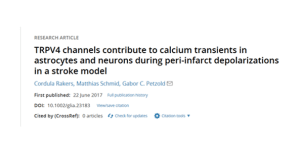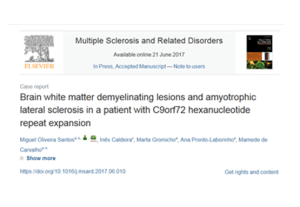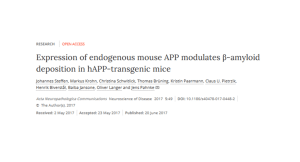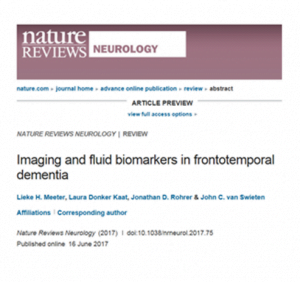 « Point mutations in transactive response DNA-binding protein 43 (TDP-43)’s N-terminal domain compromise its stability, dimerization and functions « has been published in the Journal of Biological Chemistry. This work was supported in part by JPND through the RiMod-FTD project, selected in the 2012 Risk Factors call.
« Point mutations in transactive response DNA-binding protein 43 (TDP-43)’s N-terminal domain compromise its stability, dimerization and functions « has been published in the Journal of Biological Chemistry. This work was supported in part by JPND through the RiMod-FTD project, selected in the 2012 Risk Factors call.
Author Archives: jpnd
Working with human brain tissue samples and genetically engineered mice, researchers report that consequences of low levels of the protein NPTX2 in the brains of people with Alzheimer’s disease (AD) may change the pattern of neural activity in ways that lead to the learning and memory loss that are hallmarks of the disease.
This discovery, published in the journal eLife, may one day help experts develop new and better therapies for Alzheimer’s and other forms of cognitive decline.
Clumps of proteins called amyloid plaques, long seen in the brains of people with AD, are often blamed for the mental decline associated with the disease. But autopsies and brain imaging studies reveal that people can have high levels of amyloid without displaying symptoms of AD, calling into question a direct link between amyloid and dementia.
This new study shows that when the protein NPTX2 is « turned down » at the same time that amyloid is accumulating in the brain, circuit adaptations that are essential for neurons to « speak in unison » are disrupted, resulting in a failure of memory.
« Immediate early genes” are a set of genes that are activated almost instantly in brain cells when people and other animals have an experience that results in a new memory. The gene NPTX2 is one of these immediate early genes that gets activated and makes a protein that neurons use to strengthen « circuits » in the brain.
Intrigued by previous studies indicating altered patterns of activity in brains of individuals with Alzheimer’s, the researchers wondered whether altered activity was linked to changes in immediate early gene function.
To get answers, they first turned to a library of 144 archived human brain tissue samples to measure levels of the protein encoded by the NPTX2 gene. NPTX2 protein levels, they discovered, were reduced by as much as 90 percent in brain samples from people with AD compared with age-matched brain samples without AD. By contrast, people with amyloid plaques who had never shown signs of AD had normal levels of NPTX2. This was an initial suggestion of a link between NPTX2 and cognition.
To study how lower-than-normal levels of NPTX2 might be related to the cognitive dysfunction of AD, the researchers examined mice bred without the rodent equivalent of the NPTX2 gene.
Tests showed that a lack of NPTX2 alone wasn’t enough to affect cell function as tested in brain slices. But then the researchers added to mice a gene that increases amyloid generation in their brain. In brain slices from mice with both amyloid and no NPTX2, fast-spiking interneurons could not control brain « rhythms » important for making new memories. Moreover, a glutamate receptor that is normally expressed in interneurons and essential for interneuron function was down-regulated as a consequence of amyloid and NPTX2 deletion in mouse and similarly reduced in human AD brain.
The researchers say the results suggest that the increased activity seen in the brains of AD patients is due to low NPTX2, combined with amyloid plaques, with consequent disruption of interneuron function. And if the effect of NPTX2 and amyloid is synergistic — one depending on the other for the effect — it would explain why not all people with high levels of brain amyloid show signs of AD.
The scientists then examined NPTX2 protein in the cerebrospinal fluid (CSF) of 60 living AD patients and 72 people without AD. Lower scores of memory and cognition on standard AD tests, they found, were associated with lower levels of NPTX2 in the CSF. Moreover, NPTX2 correlated with measures of the size of the hippocampus, a brain region essential for memory that shrinks in AD. In this patient population, NPTX2 levels were more closely correlated with cognitive performance than current best biomarkers — including tau, a biomarker of neurodegenerative diseases, and a biomarker known as A-beta-42, which has long been associated with AD. Overall, NPTX2 levels in the CSF of AD patients were 36 to 70 percent lower than in people without AD.
According to the researchers, NPTX2 could constitute a new mechanism that has not previously been studied in animal models, and for this reason could lead to exciting new discoveries. More work is needed, they say, to understand why NPTX2 levels become low in AD and how that process could be prevented or slowed.
Paper: “NPTX2 and cognitive dysfunction in Alzheimer’s Disease”
Reprinted from materials provided by Johns Hopkins Medicine.
 « TRPV4 channels contribute to calcium transients in astrocytes and neurons during peri-infarct depolarizations in a stroke model » has been published in the journal GLIA. This work was supported in part by JPND through the DACAPO-AD project, selected in the 2015 JPco-fuND call.
« TRPV4 channels contribute to calcium transients in astrocytes and neurons during peri-infarct depolarizations in a stroke model » has been published in the journal GLIA. This work was supported in part by JPND through the DACAPO-AD project, selected in the 2015 JPco-fuND call.
Cell biologists have discovered the protein that may be the crucial traffic regulator for the transport of vital molecules inside nerve cells. When this traffic regulator is removed, the flow of traffic comes to a halt. The resulting ‘traffic jams’ are reported to play a key role in neurodegenerative diseases such as Alzheimer’s and Parkinson’s disease. The discovery of this traffic regulator may therefore be crucial for a better understanding of the development of neural disorders. The results were published in Neuron.
In most neurons, an area between the cell body and the axon called the ‘axon initial segment’ serves as a checkpoint: only some molecules can pass through it. This area has stumped scientists for more than a decade. Why should one type of molecule be able to pass through this area, while others cannot? The answer is to be found in the traffic regulator, a protein called MAP2.
The cell biologists first discovered that larger quantities of MAP2 accumulate between the cell body and the axon. When they removed MAP2 from the neuron, the normal pattern of molecule movement changed. Certain molecules suddenly ceased to enter the axon, whereas others accumulated in the axon instead of passing through to the cell body. This abnormal transport indicates that MAP2 is the driving force behind transport within the axon.
The researchers went on to make another very important discovery. Since axons are so long, transport in the neurons is carried out by sets of proteins — known as ‘motor proteins’ — that carry packages of other proteins on their back. As it turns out, MAP2 is able to switch a specific ‘motor protein’ on or off, like a car key. This means that MAP2 actually controls which packages of molecules may enter the axon and which may not. Targeting the activity of the transport engine allowed the researchers to make another interesting discovery: MAP2 is also able to control the delivery of molecules at specific points along the axon.
Noting the link to a range of neurodegenerative diseases – including Alzheimer’s, Parkinson’s and Huntington’s disease – the researchers say that they hope their discovery could lead to new targets and potential disease-modifying therapies.
Paper: “MAP2 Defines a Pre-axonal Filtering Zone to Regulate KIF1- versus KIF5-Dependent Cargo Transport in Sensory Neurons”
Reprinted from materials provided by Utrecht University.
 « Brain white matter demyelinating lesions and amyotrophic lateral sclerosis in a patient with C9orf72 hexanucleotide repeat expansion » has been published in the journal Multiple Sclerosis and Related Disorders. This work was supported in part by JPND through the ONWebDUALS project, selected in the 2013 Preventive Strategies call.
« Brain white matter demyelinating lesions and amyotrophic lateral sclerosis in a patient with C9orf72 hexanucleotide repeat expansion » has been published in the journal Multiple Sclerosis and Related Disorders. This work was supported in part by JPND through the ONWebDUALS project, selected in the 2013 Preventive Strategies call.
Parkinson’s disease may start in the gut and spread to the brain via the vagus nerve, according to a new study published in Neurology. The vagus nerve extends from the brainstem to the abdomen and controls unconscious body processes like heart rate and food digestion.
The preliminary study examined people who had resection surgery, removing the main trunk or branches of the vagus nerve. The surgery, called vagotomy, is used for people with ulcers. Researchers used national registers to compare people who had a vagotomy over a 40-year period to people from the general population.
When the researchers analyzed the results for the two different types of vagotomy surgery, they found that people who had a truncal vagotomy at least five years earlier were less likely to develop Parkinson’s disease than those who had not had the surgery and had been followed for at least five years. In a truncal vagotomy, the nerve trunk is fully resected. In a selective vagotomy, only some branches of the nerve are resected.
After adjusting for factors such as chronic obstructive pulmonary disease, diabetes, arthritis and other conditions, the researchers found that people who had a truncal vagotomy at least five years before were 40 percent less likely to develop Parkinson’s disease than those who had not had the surgery and had been followed for at least five years.
The researchers say that their results could add to other research that has indicated that Parkinson’s disease may start in the gut. For example, previous studies have shown that a protein linked to Parkinson’s disease has been found in the gut of people who later go on to develop the disease. The theory is that these proteins can fold in the wrong way and spread that mistake from cell to cell.
Even though the study was large, the researchers say that one limitation was small numbers in certain subgroups. Also, the researchers could not control for all potential factors that could affect the risk of Parkinson’s disease, such as smoking, coffee drinking or genetics.
Paper: “Vagotomy and Parkinson disease: A Swedish register–based matched-cohort study”
Reprinted from materials provided by the American Academy of Neurology (AAN).
The Network of Centres of Excellence in Neurodegeneration (CoEN) is now accepting applications to its 2017 Pathfinder III call.
CoEN is an international initiative involving nine research funders in Europe and Canada that aims to build productive collaborative research activity in neurodegeneration research across borders. CoEN is aligned with JPND although it operates as an independent entity.
With this latest call, CoEN seeks to address the need for innovative research to underpin new approaches to therapeutic intervention. It is expected that teams will combine the research strengths across centres of excellence (CoEs) in at least two partner countries to provide a true value-added collaborative effort that will advance our approach to neurodegeneration research.
This call for Pathfinder projects is being launched by seven of the nine research funders that are members of CoEN:
- Agence Nationale de la Recherche, ANR (France)
- Canadian Institutes of Health Research, CIHR (Canada)
- Deutsches Zentrum für Neurodegenerative Erkrankungen, DZNE (Germany)
- Instituto de Salud Carlos III, ISCIII (Spain)
- Ministero della Salute, MDS (Italy)
- Medical Research Council, MRC (UK)
- Science Foundation Ireland, SFI (Republic of Ireland)
These seven agencies are contributing approximately €5.5M to fund awards made under the call involving their national CoEs.
To learn more about the call and to apply, visit the CoEN call page.
 « Expression of endogenous mouse APP modulates β-amyloid deposition in hAPP-transgenic mice » has been published in the journal Acta Neuropathologica Communications. This work was supported in part by JPND through the NeuroGEM project, selected in the 2013 Cross-Disease Analysis call and through the PROP-AD project, selected in the 2015 JPco-fuND call.
« Expression of endogenous mouse APP modulates β-amyloid deposition in hAPP-transgenic mice » has been published in the journal Acta Neuropathologica Communications. This work was supported in part by JPND through the NeuroGEM project, selected in the 2013 Cross-Disease Analysis call and through the PROP-AD project, selected in the 2015 JPco-fuND call.
Unique graphic characters called “Greebles” may prove to be valuable tools in detecting signs of Alzheimer’s disease (AD) decades before symptoms become apparent, according to a study published in the Journal of Alzheimer’s Disease.
The research showed that cognitively normal people who have a genetic predisposition for AD have more difficulty distinguishing among these novel figures than individuals without genetic predisposition.
AD is characterized by the presence of beta amyloid plaques and tau neurofibrillary tangles in the brain. Tau tangles predictably develop first in the perirhinal and entorhinal cortices of the brain, areas that play a role in visual recognition and memory. The researchers developed cognitive tests designed to detect subtle deficiencies in these cognitive functions. They hoped to determine whether changes in these functions would indicate the presence of tau tangles before they could be detected through imaging or general cognitive testing.
Subjects ranged in age from 40-60 and were considered at-risk for AD due to having at least one biological parent diagnosed with the disease. A control group of individuals in the same age range whose immediate family history did not include AD was also tested.
The subjects completed a series of « odd-man-out » tasks in which they were shown sets of four images depicting real-world objects, human faces, scenes and Greebles in which one image was slightly different than the other three. The subjects were asked to identify the image that was different.
The at-risk and control groups performed at similar levels for the objects, faces and scenes. For the Greebles, however, the at-risk group scored lower in their ability to identify differences in the images. Individuals in the at-risk group correctly identified the distinct Greebles 78 percent of the time, whereas the control group correctly identified the odd Greeble 87 percent of the time.
The scientists say that they would like to see further research to determine whether the individuals who performed poorly on the test actually developed AD in the future.
Paper: “Family History of Alzheimer’s Disease is Associated with Impaired Perceptual Discrimination of Novel Objects”
Reprinted from materials provided by the University of Louisville.
 « Imaging and fluid biomarkers in frontotemporal dementia » has been published in the journal Nature Reviews Neurology. This work was supported in part by JPND through the PreFrontALS project, selected in the 2013 Preventive Strategies call.
« Imaging and fluid biomarkers in frontotemporal dementia » has been published in the journal Nature Reviews Neurology. This work was supported in part by JPND through the PreFrontALS project, selected in the 2013 Preventive Strategies call.
